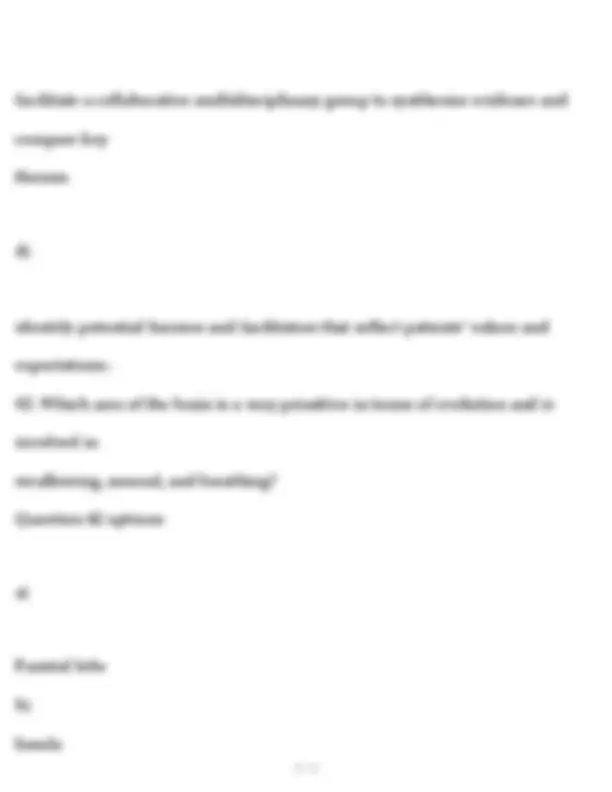






























































































Study with the several resources on Docsity

Earn points by helping other students or get them with a premium plan


Prepare for your exams
Study with the several resources on Docsity

Earn points to download
Earn points by helping other students or get them with a premium plan
Community
Ask the community for help and clear up your study doubts
Discover the best universities in your country according to Docsity users
Free resources
Download our free guides on studying techniques, anxiety management strategies, and thesis advice from Docsity tutors
A series of multiple choice questions and answers related to the ancc pmnp exam. It covers various topics in psychiatric and mental health nursing, including personality disorders, biopsychosocial case formulation, brief dynamic therapy, treatment of mania, communication in therapy, neurotransmitters, antidepressants, suicide prevention, anxiety disorders, borderline personality disorder, medication management, brain structures and functions, cognitive therapy, schizotypal personality disorder, crisis intervention, scope of practice for nurse practitioners, biopsychosocial case formulation, existential therapy, research methodology, brain plasticity, and more. A valuable resource for students and professionals preparing for the ancc pmnp exam.
Typology: Exams
1 / 185

This page cannot be seen from the preview
Don't miss anything!





























































































Narcissistic b)
Paranoid c) Antisocial d) Histrionic: Antisocial
Genetic influences and adverse circumstances of birth b) Substance use and medical disorders c) Cognitive deficits and dysregulation of emotions d)
Interventions that address impairment of vocational functioning d) Interventions for self-management of finance: Protecting the patient's biopsy- chosocial safety
Promote a therapeutic alliance and increase understanding. b) Prompt a disclosure of past successes and failures. c) Bring about changes in behavior. d) Educate the patient about what is important to disclose.:
b) Dopamine c) Gamma-aminobutyric acid d) Glutamate: Gamma-aminobutyric acid
c)
Tricyclic antidepressants (TCAs) d) Serotonin norepinephrine reuptake inhibitors (SNRIs): Tricyclic antidepressants (TCAs)
a) :assist the staff in developing a treatment plan that limits contact with the patient to one person per shift.
b)
develop a "no suicide" pact with the patient to decrease his helplessness and increase his feelings of control.
c)
encourage the patient to express his fears of improving and being abandoned or of leaving the safe environment.
d)
increase supervision and restrict milieu participation to decrease the sec- ondary gain from manipulation.: encourage the patient to express his fears of improving and being abandoned or of leaving the safe environment.
b)
has failed to master object constancy. c) is employing primitive idealization. d) is employing projective identification.
major depressive disorder. The patient reports an improved and stable mood on a trial of duloxetine (Cymbalta), but experiences continued neuropathic pain. The nurse practitioner's initial intervention is to:: add gabapentin (Neu- rontin) to the treatment regimen.
b)
conduct additional diagnostic tests. c)
contact the patient's endocrinologist. d)
increase the dosage of duloxetine (Cymbalta).
b)
Basal ganglia c)
Corpus callosum d) Hypothalamu s
Frontal lobe b) Temporal lobe c) Parietal lobe d)
Occipital lobe: Frontal lobe
Use of immature defense mechanisms b) Learned behavior of helplessness c) Automatic negative thoughts
by:
a) advising the survivors to consider using a hypnotic medication for a brief period.
b)
educating the survivors about prodromal symptoms of posttraumatic stress disorder.
c)
encouraging the survivors to rest during the day.
d)
suggesting that the survivors join a posttrauma support group.: educating the survivors about prodromal symptoms of posttraumatic stress disorder.
ability of nurse practitioners to provide health care that patients need. b) fact that nurse practitioners are caring in their patient care delivery. c) importance of broadening the scope of nursing practice. d) necessity of offering equivalent services both to urban and rural patients: - .ability of nurse practitioners to provide health care that patients need.
Determine patient's level of social support: Generate an understanding of the person as a whole
a)
Attempting to understand a patient's subjective world b) Challenging a patient's irrational beliefs c) Developing specific plans for change d) Establishing general group goals: Attempting to understand a patient's subjective world
b)
be statistically significant, but will not be clinically significant. c)
not be statistically significant, because the research design was quasi-experimental instead of experimental.
d)
not be statistically significant, because the research was poorly conducted.